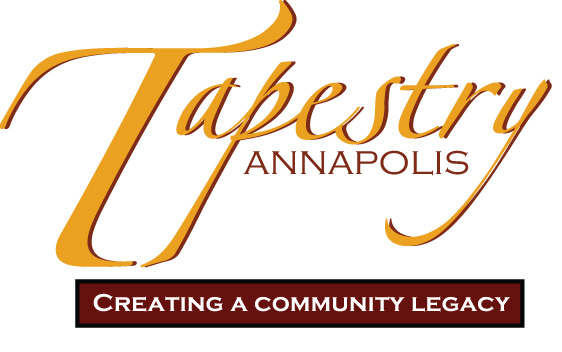Twelve smaller tapestries have been designed to display images that were not appropriate for, or able to be portrayed on, the large 18th Century piece. While the stitching on the large tapestry panels is being completed by those with years of expertise in needlework, the small ones are designed to provide for the community to participate in this project.
To date, eight of these 18th century canvases have been completed and are in the process of being block and finished for the 2012 Historic Annapolis Museum Exhibit. The size of the small tapestries is dictated by the images to be portrayed on the canvas. Here are photographs of the unstitched, hand painted canvases along with their size and a brief description of the subject matter.
William Paca, Charles Carroll of Carrollton, Thomas Stone and Samual Chase all lived in Annapolis and some time during their lives and homes associated with all four still survive. 18″x24″ in size
Stitched by citizens of Annapolis Royal in Nova Scotia, sister city of Annapolis MD.
The Annapolis Flag
The white background of the Annapolis Flag is derived from the militia flag selected by Francis Nicholson, the R oyal Governor who moved Maryland’s capital to Annapolis. The crown is a tribute to Queen Anne, for whom Annapolis i s named. The entwined rose and thistle are Queen Anne’s heraldic badge and represent Britain (the Tudor family rose) and Scotland (the thistle) united in 1707 as the Kingdom of Great Britain. 10″x12″ in size
oyal Governor who moved Maryland’s capital to Annapolis. The crown is a tribute to Queen Anne, for whom Annapolis i s named. The entwined rose and thistle are Queen Anne’s heraldic badge and represent Britain (the Tudor family rose) and Scotland (the thistle) united in 1707 as the Kingdom of Great Britain. 10″x12″ in size
A shilling minted by John Chalmers in Annapolis. Chalmers coins were the first silver coins minted in the United States. 10″x12″ in size
Nancy Hallam 1771
 A member of a touring English theatrical company, she first arrived in Annapolis in September 1770 at the height of her popularity. Her portrait by Charles Willson Peale, done when the company returned to the City the next year, shows Hallum as Imogen, disguised as the boy Fidele, in Shakespeare’s Cymbeline. 10″x12″ in size
A member of a touring English theatrical company, she first arrived in Annapolis in September 1770 at the height of her popularity. Her portrait by Charles Willson Peale, done when the company returned to the City the next year, shows Hallum as Imogen, disguised as the boy Fidele, in Shakespeare’s Cymbeline. 10″x12″ in size
Declaration of Independence signer William Paca House Garden 1765-1780
The lower part of the William Paca Garden, showing the bridge over the fish pond and summer house. 10″x12″ in size
Tuesday Club Illustration 1749
The Tuesday Club was a men’s social club that met in Annapolis from 1745 to 1756. Dr. Alexander Hamilton, founder of the Club, wrote a history of the club which he illustrated with scenes of the club’s activities. 10″x12″ in size
Used by Jonas Green as a means of protesting the British Stamp Act of 1765, the Death Head’s type was printed on the Maryland Gazette where the official British revenue stamp should have been. 10″x12″ in size
Sands House 1771
 One of the oldest and most significant frame houses in Annapolis, it has been the home of one family since John and Ann Sands bought it in 1771. The home’s architecture and contents reflect the change in taste and lifestyles of a family, neighborhood and town from colonial day to the present. 18″x24″ in size
One of the oldest and most significant frame houses in Annapolis, it has been the home of one family since John and Ann Sands bought it in 1771. The home’s architecture and contents reflect the change in taste and lifestyles of a family, neighborhood and town from colonial day to the present. 18″x24″ in size
Stitched by students and staff of Montessori International Children’s House, Annapolis MD.
Individuals who helped stitch the small 18th century tapestries that will be on exhibit at the Historic Annapolis Museum throughout 2012 include:
Vicki Aube
Doris Muller-Burton
Janet Rotoli (formerly Lloyd)
Jean Russo
Renata Shelton
Katie Williams
The following tapestries have not been stitched and so will not be displayed (other than by photograph) at the Historic Annapolis Museum Exhibit opening late January 2012, These pieces will be completed in 2012:
Othello at Whitehall 1762-1775
Othello was a Thoroughbred horse, imported into Maryland by Col. Benjamin Tasker.  He is shown here at his final home, the Whitehall estate of Governor Horatio Sharpe, which overlooks Whitehall Bay in Anne Arundel County.
He is shown here at his final home, the Whitehall estate of Governor Horatio Sharpe, which overlooks Whitehall Bay in Anne Arundel County.
Sparrows Seal 1765 (To be stitched by one of our volunteers on most weekend afternoons at the Historic Annapolis Museum, 99 Main Street, Annapolis)
This seal first appeared in 1765 on the title page of the Reverand Thomas Bacon’s compilation of the Laws of Maryland. Carved on wood block by Thomas Sparrow, ward and employee of the Annapolis printer, Jonas Green, the Sparrow seal bear the latin motto, “Crescite et Multiplicamini” which means “Increase and Multiply”.
This was a common boat used on the Chesapeake Bay from the earliest days of the colony. It was a round bottomed and open, that is un-decked, craft that could be rowed or sailed. Shallops were general purpose boats used for carrying people and goods throughout the Bay.
Frye-Jefferson Cartouche 1775
Cartouche from a map of Virgnia and Maryland, drawn by Joshua Frye and Peter Jefferson (father o f Thomas) showing planters and tobacco merchants negotiating over a cargo, while workers load hogsheads of tobacco.
f Thomas) showing planters and tobacco merchants negotiating over a cargo, while workers load hogsheads of tobacco.




